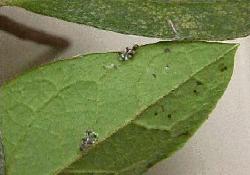Source(s): Jacob G Price
The azalea lace bug attacks azaleas and a few other ornamentals. They damage plants by feeding on sap from leaves through sucking mouth parts. Lace bugs often go undetected on the undersides of leaves until their numbers are high. Prolonged attacks can severely weaken azaleas and may be the primary cause of death.
Description
Adult lace bugs are about 1/8 of an inch long, flattened and rectangular shaped. The wings are almost transparent. Nymphs are flat, oval, and have spines projecting from their bodies in all directions. Both nymphs and adults cause damage which is seen as many chlorotic spots on the leaf. Brown and black excrement and old skins are often seen under the leaves.
Biology
Eggs are transparent to cream colored and football shaped. The eggs overwinter on the undersides of leaves and hatch in March to early April. Development from egg through five nymphal instars, to adult takes a month. There are at least four generations per year.
Cultural Control
If only a few lace bugs are present, they may be washed off with a strong stream of water. Also natural predators such as Mirid plant bugs and the mymarid wasp help control the azalea lace bug. Azaleas in full sun appear to have heavier infestations.
Resource(s): Insect Pests of Ornamental Plants
- Growing Asparagus: A Luxury Vegetable - September 24, 2013
- Frizzle Top in Sago Palms - September 24, 2013
- Growing Onions in the Home Garden - September 24, 2013
